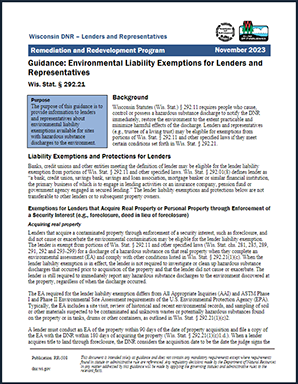State Liability Exemptions for Lenders & Representatives
Lending institutions may be eligible for state environmental liability protection at contaminated properties when:
- Conducting regular lending activities, such as mortgage lending
- Acquiring property through foreclosure
- Inspecting property
- Enforcing a security interest in personal property and fixtures
Representatives, such as trustees or fiduciaries, may be eligible for state environmental liability protection when acting in their capacity as a representative.
Detailed information is available in Guidance: Environmental Liability Exemption for Lenders and Representatives (RR-508).
The state environmental liability exemption does not provide an exemption or defense to federal environmental liability or federal or state laws for storage tanks. For additional information on federal liability and storage tank regulations, contact the U.S. Environmental Protection Agency. Contact the Wisconsin Department of Agriculture, Trade and Consumer Protection regarding state storage tank regulations.
Lenders Who Foreclose On Contaminated property
Lenders that acquire contaminated property through foreclosure (or other methods of enforcing a security interest) may be eligible for a state environmental liability exemption. To be exempt, the lender must meet certain conditions:
- The lender cannot have caused or exacerbated the contamination.
- The lender must report the contamination to the Wisconsin Department of Natural Resources (DNR) and take any emergency actions needed to protect human health and the environment.
- The lender must complete an environmental assessment of the property within 90 days of acquisition and submit the environmental assessment to the DNR within 180 days of acquisition. Typically, the environmental assessment includes a site visit, review of historical and environmental records and sampling. If the environmental assessment was completed more than a year before the property was acquired by the lender, a visual inspection and DNR review are also needed to be eligible for the exemption.
To submit an environmental assessment to the DNR, use the Lender Liability Exemption Environmental Assessment Tracking (Form 4400-196). Submit the form and attachments using the RR Submittal Portal.
To submit a request for liability clarification and DNR review of an environmental assessment, submit the required fee and use the Technical Assistance, Environmental Liability Clarification or Post-Closure Modification Request (Form 4400-237). Submit the form and attachments using the RR Submittal Portal.
Lending Activities
Generally, lenders conducting lending activities at contaminated properties are exempt from state environmental liability. The lender cannot be the causer of the contamination or cause the contamination to be exacerbated. Liability clarification from the DNR is available. To submit a request, use the Technical Assistance, Environmental Liability Clarification or Post-Closure Modification Request (Form 4400-237) and submit the required fee.
Other Activities
Other activities may be eligible for a state environmental liability exemption, including inspections, foreclosing on personal items and fixtures and acting as a representative of an estate or trust. For additional information see Guidance: Environmental Liability Exemption for Lenders and Representatives (RR-508).
Liability Assistance
When requested and the required fee is received, the DNR can provide clarification of liability to lenders and representatives. To request a liability clarification letter from the DNR, submit the required fee and use the Technical Assistance, Environmental Liability Clarification or Post-Closure Modification Request (Form 4400-237). Submit the form and attachments using the RR Submittal Portal.

